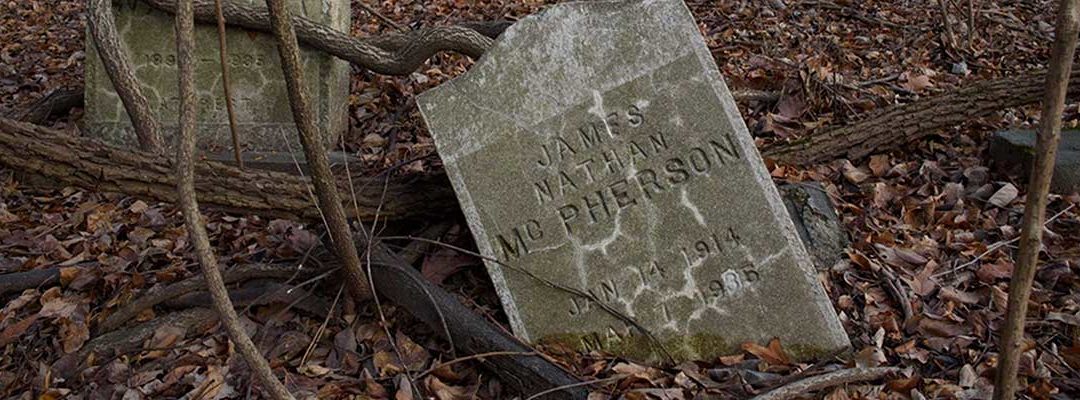
Powerful Stories Hidden in Abandoned Cemeteries

Gravestones at St. George Cemetery in southern Illinois. (Nick Schnelle for ProPublica Illinois)
This article originally appeared on ProPublica.org.
It’s impossible to see from the street, so you would never know it’s there.
To get to St. George Cemetery, especially its oldest section, you have to make your way past branches and thorns, across the weathered hills and over downed trees. Eventually, dozens of scattered headstones, some of them knocked over, come into view. And there, sitting upright is the gravestone of William Chapman, an African-American veteran of the Civil War who died March 21, 1904.
My interest in abandoned African-American cemeteries started in graduate school when I was assigned to write a story about a black woman named Rose Sturdivant Young, who was leading the charge to restore an abandoned cemetery in North Carolina. Her father, mother and other ancestors are buried there.
African-American cemeteries across the country have largely been neglected, their powerful histories obscured by weeds, debris and, as much as anything, the passage of time. Few people know their locations. Fewer still know the stories of the people buried there.
When I came to ProPublica Illinois as a reporting fellow, I saw a chance to look into this issue. I focused on two cemeteries in St. Clair County, a few miles southeast of St. Louis across the Mississippi River: St. George and Booker T. Washington Cemetery. I spent time hiking the grounds with folks who are trying to unearth and preserve the histories of the cemeteries, as well as trying to keep up the cemeteries themselves.
Both cemeteries once served as the final resting places for the black communities in and around St. Clair County. Of the thousands of people buried in the two cemeteries, close to 30 African-American veterans have been identified, including at least one — Chapman — from the Civil War. But they were more than just cemeteries. Black residents, according to local lore, used Booker T. Washington as a shelter during the East St. Louis race riots in 1917, when white mobs murdered dozens of black citizens. After the riots, many of the victims of the violence supposedly were buried there.
“The black cemeteries are being destroyed, accidentally or on purpose,” said Judy Jennings, a U.S. Air Force contract specialist and amateur historian who, for nearly two decades, has been researching the cemeteries, especially Booker T. Washington. “It’s important to preserve this history.”
It’s difficult to estimate the number of abandoned cemeteries among the thousands of licensed and unlicensed cemeteries in Illinois. The state doesn’t seem to keep track and no one, as far as I can tell, has studied the issue in enough detail to compile a list. But funeral home directors and others I spoke with said there could be many, from plots on private farms and other family property to large cemeteries like St. George and Booker T. Washington.
As segregation eased over the decades and other cemeteries began to allow blacks to be buried, Booker T. Washington and St. George became overgrown and neglected. Over time, many people forgot they existed.
Today, Booker T. Washington sits in a large bowl at the bottom of a hill and frequently floods. Conditions at St. George, which is hidden deep in the woods, are worse. In fact, logging trucks drove through the cemetery in July 2016 and crushed a number of the headstones. Police investigated the incident but no one was charged.
After spending time in St. Clair County and talking with descendants of some of those buried at Booker T. Washington and St. George, as well as with researchers like Jennings, I concluded the abandonment of the cemeteries was mostly the result of a series of unfortunate circumstances, instead of deliberate neglect.
Other abandoned cemeteries probably faced similar fates. People stopped burying loved ones there and, because these are not public lands, there’s no taxpayer money to maintain them. Over time, no one was left to do the weeding and other necessary upkeep. Owners — private citizens when they opened — died and, according to the St. Clair County Genealogical Society, which has studied the cemeteries, it was unclear who took over ownership.
Only a few descendants still try to maintain plots.
Perhaps the best we can do after so many years is recognize that these cemeteries were once central to African-American communities and learn what we can from them. If you are aware of any abandoned historically black cemeteries in Illinois or know of historical societies researching this area, please get in touch. Email me at [email protected].
